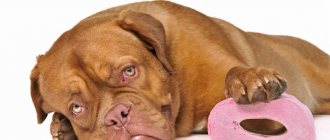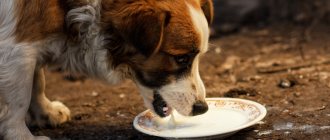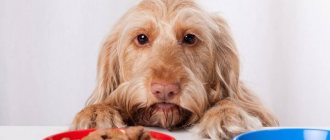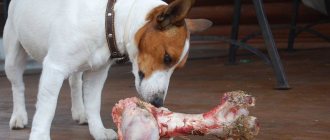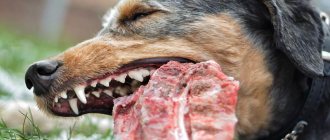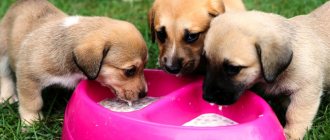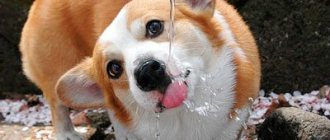What you should absolutely not feed your pet
The list of prohibited foods for dogs is extensive. Of course, if your pet accidentally swallows a piece of food that is not allowed, nothing bad will happen. But if you feed your dog this way constantly or in large quantities, his health will certainly deteriorate.
The most dangerous food
A number of products lead to serious consequences. The owners know about them, but some stubbornly ignore the prohibitions and continue to give “goodies”. Such foods include:
- Spicy, smoked, marinated, seasoned, salty dishes, sausages. The abundance of salt and fat provokes inflammation of the pancreas, liver, volvulus, obesity, disrupts the water-salt balance, the functioning of the liver, joints, and increases blood pressure.
- Chocolate. Contains theobromine, which leads to poisoning, convulsions, arrhythmia, and in large quantities – death.
- Alcohol. It threatens with intoxication, heart failure, paralysis of the nervous system, and death.
- Sweet. Destroys teeth, leads to diabetes, obesity, and gastrointestinal disorders.
- Yeast dough products. They cause fermentation, lead to painful colic, and occasionally to rupture of the intestinal walls.
- Coffee and tea. Caffeine in drinks is harmful to the heart, nervous system, and disrupts the functioning of the digestive system.
Animal products
Dogs are predators and meat eaters. But not all meat is equally healthy. So, animals cannot be fed:
- Fish, chicken, tubular bones. The fragments damage the digestive tract, can get stuck between the teeth, in the throat, and lead to suffocation.
- Raw river fish. Risk of infection with helminths, injury from small bones.
- Milk. Absorbed only by puppies, it causes diarrhea in adult pets.
- Raw chicken eggs. The enzyme avidin inhibits the synthesis and absorption of vitamin B1, which leads to skin and coat diseases. Salmonella infection is also possible.
Plant food
Vegetables, fruits, berries, and cereals supply the pets’ body with vitamins; without them, normal functioning of the digestive organs is impossible. However, a number of plant products are dangerous for dogs.
Prohibited fruits and vegetables:
- Peaches, persimmons, plums. Lead to intestinal obstruction.
- Grapes, raisins, currants. Causes kidney failure. Although some dogs, regardless of breed, tolerate berries well, it’s not worth the risk.
- Citrus fruits, kiwi, pineapples. Lead to allergies and stomach inflammation.
- Avocado. The poisonous element persin leads to intoxication.
- Raw cabbage. Provokes increased gas formation.
- Potatoes – raw, boiled, fried. Contains a lot of easily digestible carbohydrates, starch and solanine, which are harmful to the pet's body.
- Broccoli. Toxic in large quantities due to isocyanate.
- Onion and garlic. The presence of thiosulfates provokes anemia.
- Fruit and pomegranate seeds. Causes intestinal obstruction and contains cyanide, which is poisonous to dogs.
Harmful grains, greens and more:
- Legumes. They are poorly digested and absorbed, leading to flatulence.
- Corn. An allergen that causes stomach upset, damages teeth, and increases blood sugar levels.
- Sorrel and rhubarb. Due to oxalates, the functioning of the urinary system is disrupted.
- Spinach. Contains a toxic substance, oxalate, which is harmful in large quantities.
- Hop. Provokes shortness of breath, convulsions, fever and increased heart rate.
- Porridges made from corn, wheat, semolina, pearl barley. They are poorly absorbed and digested, causing bloating.
- Mushrooms. There is a high probability of poisoning; they contain chitin, which is harmful to the liver and pancreas.
- Nuts. They are not absorbed by canines and disrupt the functioning of the gastrointestinal tract.
The list of foods that should not be given to dogs will be useful not only for adherents of natural food, but also for those who feed their dogs industrial food. If the composition contains one of the above ingredients, you should not purchase the product.
What to feed your pets?
Any recommendations from veterinarians in case of heat start with one thing: the animal may not eat, but it must drink. What exactly should I give him, in what quantity, at what time, and is it possible to give him something else besides water?
Bottle or tap?
The main drink for cats and dogs is the same as for their owners: ordinary clean water. It is advisable to use bottled drinking water, but you can also give regular tap water, passed through a household filter. It is good to give spring and well water to drink, but after warming it up, ice water should not be given to animals, so as not to solve the problem of sore throat later. The animal will decide how much to drink; your task is to ensure an uninterrupted water supply.
For example, it is not enough to pour your dog a bowl of water (about 1.5 liters) and leave for work all day - on a hot day, she may need two such servings.
At home or on a walk?
What is harmful to humans will not benefit animals either. Therefore, no attempts to drink from a puddle. You cannot give dogs and cats water from a lake, pond or river. If you take them outdoors, think about what they will drink. In a real, non-suburban polluted forest, you can give people to drink from streams or springs, in other cases - only the water that you drink yourself. You can drink from a special traveling bowl made of waterproof fabric - when folded, it will even fit in your pocket.
Plastic or metal?
At home, experts advise pouring water into ceramic bowls. In the case of cats, it is desirable to have a dark color so that the animal can see the surface of the water. Ceramics do not release anything into the water, and in such a bowl the water stays fresh longer.
You can also drink from plastic and metal cups, but cats are not always willing to drink from them due to the taste present in the water, and some dogs experience irritation when they come into contact with wet metal. This applies to breeds with skin folds (body folds) on the neck - basset dogs, sharpeis, pugs, chow chows, mastino dogs and bearded dogs - schnauzers, bearded collies, terriers. Such animals must wipe their faces after drinking so that the wet fur does not rot, irritating the skin.
Drink the tea yourself, share the kefir with the cat
Milk. It's possible, but not necessary. Milk is a baby food; an adult body does not need it. After about 3–5 months, dogs have a decrease in the amount of enzymes that break down milk sugar; an adult dog that drinks milk may experience an acute attack of diarrhea. The same applies to cats, and people too.
Kefir and other fermented milk. But this is, in principle, useful for both humans and dogs. You can give kefir, yogurt, yogurt, bifidok, but not instead of water - this is still food, not drink. It is better to give fermented milk products during evening feeding as an addition to the main meal. And little by little - for a medium-sized dog, for example, 1-1.5 cups of kefir or yogurt will be enough. It’s more difficult with cats: most cats eat ready-made food, and in this case it’s not recommended to give anything other than water.
Black tea. Veterinarians allow black tea only in one case - if the animal has an attack of diarrhea and nothing else is available. It should not be hot and too sweet - slightly sweetened is better. Under normal conditions, neither a dog nor a cat needs tea and can be harmful.
Coffee. Under no circumstances, not even for fun! An animal is not a person; for him, even a tiny dose of caffeine will be shocking and can lead to overexcitation and serious problems with the cardiovascular system.
Herbal tea. Many owners give their animals herbal tea as an anthelmintic - or rather, they try to give it, because the client, as a rule, reacts disapprovingly to the bitter drink. Veterinarians also do not approve of the idea: firstly, parasites cannot be removed in this way anyway, and secondly, herbs are not at all harmless to the animal’s liver and kidneys.
Can animals have mineral water?
Traditionally, having a respectful attitude towards mineral water, people try to introduce animals to it. Is it possible to give dogs mineral water? We asked dog handler Olga Nikitenkova, an expert of the Russian Canine Federation, president of the Velikiye Luki Dog Breeders Club “Cerberus”:
– Mineral water can be given, but on condition that all gases have been removed from it. Usually they do this: buy a salty mineral water, open it, let it sit overnight and pour it into the dog’s bowl in the morning. This water allows you to replenish the salt balance in the body in hot weather. But not all dogs agree to drink mineral water; they need to be taught this from puppyhood. It is not worth giving this kind of water all the time, and there is no need for it - regular drinking water is enough for the dog. It should be fresh and cool - such water is saturated with oxygen and quenches thirst well, but the dog may refuse to drink warm water that has stood at room temperature for a long time. It is better to change the water in the bowl more often, at least twice a day. If a dog lives in a city apartment and is left alone for a long time, it is good to have a special semi- or automatic drinking bowl - then the animal will not have problems with access to fresh water.
If you don’t have regular water at hand, you can give mineral water to your cat, but, according to Yulia Didenko, a therapist at the Bely Klyk veterinary clinic, it is not advisable to constantly feed your animal with it:
– Mineral water will not lead to urolithiasis overnight – salts are deposited for more than one day, and besides, the animal must have a predisposition to this: most often stones are formed due to inflammation of the urinary tract. Mineral water with gas should definitely not be given to cats! Without gas - only if there is no table water, that is, as a last resort.
List of useful and permitted products
The list of what you can feed dogs is much shorter. But that's okay - pets don't need a lot of variety. Proper feeding will ensure the animals have a long and healthy life.
Dogs can and should be given:
- Lean meat - beef, veal, rabbit, turkey, chicken.
The basis of the “dog menu”, the main source of proteins, fats, and energy.- By-products – liver, heart, kidneys.
Contains most beneficial vitamins and elements.- Sea fish.
Source of protein, calcium, phosphorus, fatty acids.- Porridges made from rice, buckwheat, and oatmeal for puppies.
They normalize the functioning of the gastrointestinal tract and saturate the body with vitamins.- Dairy products.
They contain calcium, vitamins D, B, E, A. Kefir, yogurt and cottage cheese are necessary for the full functioning of the intestines.- Boiled chicken or quail eggs.
During heat treatment, the avidin enzyme is destroyed, but minerals, vitamins and oxidants are preserved.- Moslaki, large solid bones covered with cartilaginous tissue.
“Train” the jaws and clean the teeth.- Lettuce, parsley, dill.
Enriched with vitamins A, C, K.- Strawberries and blueberries.
Additional sources of vitamins and antioxidants improve intestinal function.- Carrots and pumpkin.
Improves vision, condition of hair and skin, and stomach function.- Cored apples and pears.
They contain many useful elements and stimulate peristalsis.- Bananas.
Rich in fiber, potassium, vitamins B, C.
What's wrong with sausage?
And now, in order, what can happen if you feed your pet sausages and sausages. The absence of meat or its low-quality composition is in itself a big minus, since food should be beneficial to the dog, without meat there is no complete nutritious protein, the main “building material” for the body’s cells, and there are no carbohydrates – a source of energy. The output is food, the purpose of which is to fill the animal’s stomach.
Sausage contains salt and spices - the main enemy of a pet's health. Salt contains chlorine and sodium necessary for the body, which maintain water and acid-base balance and participate in the functioning of the nervous system. With a deficiency of these substances, animals may experience muscle disorders, weakness, and fatigue. Puppies experience growth and developmental delays.
However, the animal’s body requires such microscopic doses of these and other minerals that it is simply impossible to measure them. If a dog’s diet is composed correctly, it receives sodium, chlorine, and all the necessary substances from other sources - meat, fish, vegetables and cereals. Additional supplements are not required, since there is a risk of exceeding the permissible doses, which will cause:
- poisoning;
- intestinal disorder;
- chronic kidney and bladder diseases.
Other spices are also added to the sausage - hot pepper and paprika, onion, garlic, nutmeg. All of them are also dangerous for animals:
- hot peppers contain capsaicin, which in dogs causes irritation to the skin, mucous membranes and eyes, walls of the stomach and intestines, impairs the functioning of the gallbladder and liver, and the organs of the urinary system. Pepper can provoke the development of gastrointestinal diseases - gastritis, ulcers and even cancer;
- paprika also irritates the esophagus and stomach, skin and eyes, and can cause diarrhea;
- garlic and onions contain thiosulfate, which is toxic to animals. It can cause anemia. Such spices can cause poisoning, and its symptoms - vomiting, diarrhea - may appear only after a few days, which does not give the owner the opportunity to associate them with the consumption of sausage and other dishes containing onions or garlic;
- nutmeg is another additive to sausages that is a real poison for a dog. Substances present in nutmeg affect the central nervous system of the animal. 2 grams are considered dangerous for humans, and for a dog much less can be fatal.
Some people believe that liver and liver sausages are safe. Offal can be included in the menu of four-legged animals, but sausage made from them contains the same spices and preservatives that can be harmful to the health of the animal.
Which of the “forbidden fruits” can sometimes be given to dogs?
It’s not always possible for owners to withstand the dog’s pitiful gaze and not pamper him with something tasty. The good news is that you can give up. In small quantities, the dog is allowed to eat:
- Pork. It is oily and may contain the plague virus and parasite eggs. But it can be given occasionally after careful heat treatment.
- Bread and flour products. Lead to excess weight, constipation, flatulence. You can pamper your pet occasionally. It is advisable to treat your dog not with buns and cookies, but with crackers and bagels.
- Celery. Contains many useful elements and vitamins. But the vegetable is coarse and fibrous, and dogs do not know how to chew - they only chop up the food and swallow it in pieces. If you want to give your dog celery, you need to grind it in a meat grinder or blender - this way the greens will easily pass through the digestive tract and be absorbed by the body.
- Cheese. Dogs love him. But the product contains lactose and fats, which are poorly digestible. Therefore, you can give low-fat varieties in small portions - as a treat or reward.
- Boiled and stewed cabbage. Heat-treated vegetables are better absorbed than raw vegetables. But the dog should be fed it carefully and occasionally.
- Peanuts and peanut butter. The only legume that is recommended for dogs in moderation. The kernels contain niacin, vegetable fats, vitamins E and group B.
- Dried fruits. Dried apricots and prunes are an excellent treat during training.
- Ice cream. Yes, harmful sweetness. But you can treat your dog once every 1-2 months. You need to take a clean filling without fillers or dyes. It is advisable to melt the dessert so that your pet does not catch a cold.
